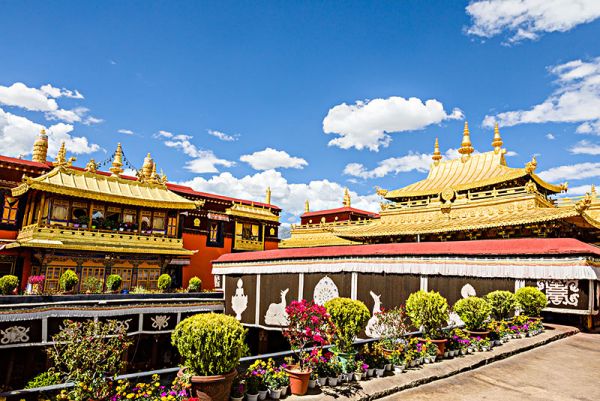Chinese Name: 大昭寺 Pronunciation: Dà Zhāo Sì
Suggested Visiting Hours: 1-2 Hours
Building Time: The Tang Dynasty (618 - 907)
Address: No.2, Barkhor West Street, Chengguan District, Lhasa
Occupied Area: More than25,100 square meters (about six acres)
Best Visiting Season: Spring, Summer and Autumn (March to October)
Popular Activities: Admire the architectures, Buddha statues, carvings and murals.
Building Function: It was built by Tibetan King Songtsen Gambo to place the life-size statue of Sakyamuni at age 8.
| Tickets | All year |
| Admission Fee | 85 yuan |
| Opening Hours | 9:00-18:00 ( From8:00 to 11:30, it's mainly open for pilgrims.) |
| Closing Time | 18:00 |
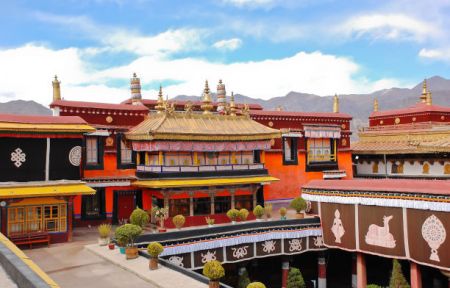
Located in the center of the old Lhasa, the Jokhang Temple was built by Songtsen Gampo in the seventh century, during the heyday of the Tubo Dynasty, with the purpose of reportedly worshiping a Buddha statue that brought by Princess Bhrukuti of Nepal from her hometown Katmandu, so the name “Jokhang” means “House of Buddha”.
It is said that it was originally a lake, but under the efforts of Songtsen Gampo, it was filled up and built into a temple. After that, the temple had been expanded once and once again and now covers an area of more than 25100 square meters.
What is worth mentioning is that the statue of Sakyamuni in Jokhang Temple is a statue of Sakyamuni at age 12 brought by Princess Wencheng of the Tang Dynasty. However, the statue of Sakyamuni at age 8 was converted to Ramoche Temple in the eighth century and later destroyed in the Great Cultural Revolution.
Jokhang Temple has the supreme status in Tibetan Buddhism. As the saying goes, “if you have not been to Jokhang Temple, you have never been to Lhasa”. There is even a saying that “there is Jokhang Temple before Lhasa City”.
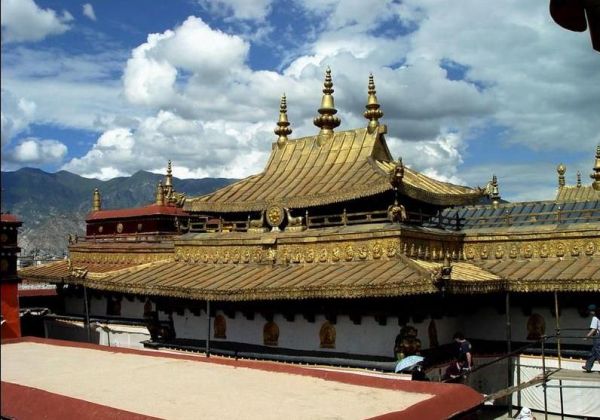
Jokhang Temple is one of the most brilliant existing buildings in Tibet, and also the earliest civil structure building in Tibet. It combines Tibetan, Tang, Nepali and Indian architectural styles, and now it becomes an ancient model of Tibetan religious architecture.
Jokhang Temple has more than 20 halls and a large number of regular cultural relics. There are more than 300 Buddha statues, 2600 square meters of murals, and a sea of ancient documents, plaques, inscriptions, Thangka, musical instruments, etc.
Looking down at the Jokhang Temple Square from the golden roof of Jokhang Temple, groups of pilgrims walk along the circle of Bajiao Street outside the Jokhang Temple. One by one, the pilgrims prostrate and kowtow at the gate of Jokhang Temple, and the line is long. The scene is very touching.
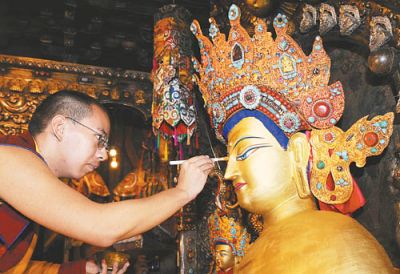
In 647, the 21st year of Zhenguan during the Tang Dynasty, the Jokhang Temple was first built by Songtsen Gampo. It was later renovated and expanded by successive dynasties, forming a huge architectural complex.
In the Jokhang Temple, the statue of Sakyamuni Buddha at age 8, brought by Princess Chizun to Tibet, was moved to Ramoche Temple after the death of Songtsen Gampo, The statue of Sakyamuni Buddha at age 12 brought by Princess Wencheng in Tibet was worshipped and enshrined at Jokhang Temple, which is the pattern we see today.
Jokhang Temple has suffered two disasters in its history. In the late 7th century, the first Buddhist ban movement initiated by the noble ministers of the primitive religion of Bon and the second Buddhist ban movement initiated by Rhondama in the mid-9th century reduced the Jokhang Temple to abattoir or closure. The Statue of Sakyamuni was buried in the ground twice.
In 1409, Master Zongkaba, the founder of the Grus Sect, called monks together from all factions of Tibetan Buddhism to praise the merits of Sakyamuni and held the Zhaoda-Dharma Conference in the monastery, which was later renamed Jokhang Temple( the first known name: “Sheep Earth God Changed Temple”).
In 1966, during the Great Cultural Revolution, the red guards attacked the Jokhang Temple and destroyed many Buddhist statues.
The Jokhang Temple became a pig slaughterhouse, and Tibetans were forbidden to worship. Until 1972, the Jokhang Temple was rebuilt and completed in 1980.
In 2000, Jokhang Temple was listed as a World Cultural Heritage as an extension of Potala Palace.
On August 3, 2009, the government started to carry out the Jokhang Temple cultural relic protection and maintenance project, with a project fund of 18.17 million yuan. The project has carried on the maintenance and protection of the Main Hall of Chuakkang, the Hall of Sakyamuni, the gallery of Thousand Buddhas, the gallery of inner passage and the subsidiary buildings.
On October 29, 2010, the protection and maintenance project of Jokhang Temple had passed the preliminary acceptance. On June 8, 2011, the project was completed and a grand completion ceremony was held in the temple.
The hall of Jokhang Temple is 4-storeys high with a typical Han style of the whole building. Watchtower and carved beams are in Tibetan style. There are 103 carved wooden animals, human faces and lion bodies that lined under the eaves of the second and third floors of the Main Hall. In addition, the Tibetan frescoes, such as "Princess Wencheng's Entry into Tibet" and "Construction of Jokhang Temple" in the temple, are nearly 1,000 meters long.
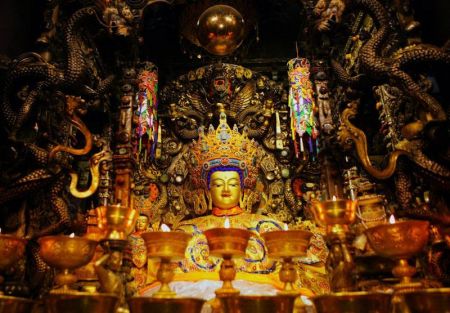
Jokhang Temple has sandalwood doorposts from the 7th century and carvings on them. In addition, the hall of Sakyamuni also has the same 7th-century wooden pillars with a number of 8. Jokhang Temple was listed as a World Heritage Site in 2000, and the most important reason is the wood carvings, which are not found in any other monastery in Tibet, except Jokhang Temple.
These wood sculptures have been as hard as iron for 1400 years, and when you hit them, they will make a sound of metal.
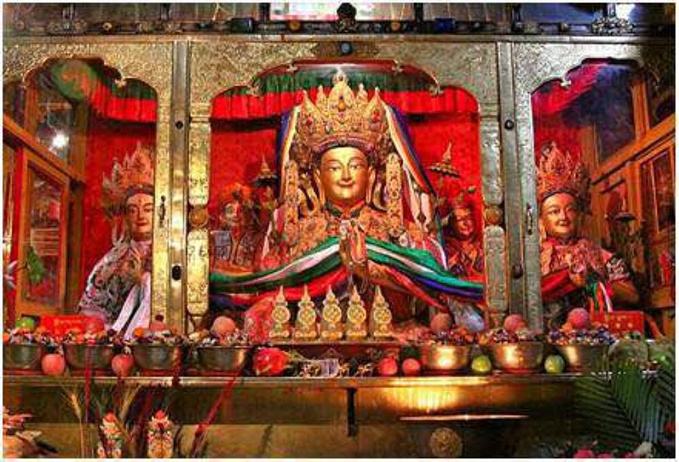
Jamba Buddha is one of the most famous Buddhas in Lhasa and it is said that it can control the weather in Tibet. Every year it is brought out with great respect and go around the Jokhang Temple before the end of the Tibetan New Year activities.
The most famous figure is the life-size statue of Sakyamuni aged 12. It is like the image of Sakyamuni Buddha when he was alive. After the statue had been sculpted, his disciples were lucky enough to ask Sakyamuni Buddha to bless the disciples themselves. The statue is precious, not only because of its historical and cultural value, but also because people think the Buddha statue is no different from the Buddha who was seen 2,500 years ago.
There are only three Buddha statues of Sakyamuni in the world. When Sakyamuni, the founder of Buddhism, was alive, he opposed idolatry and did not set up a temple for himself statue. On his deathbed, Sakyamuni only agreed to make statues of himself from three different ages and to draw them himself.
Among the three Buddha statues, the gilt bronze statue of Sakyamuni as the King's son when he was 12 years old is the most exquisite and noble. The Buddha statue then flowed into China from ancient India and was brought to Tibet by Princess Wencheng of the Tang Dynasty. The statue of Sakyamuni of age 12 is enshrined in Jokhang Temple up to now.
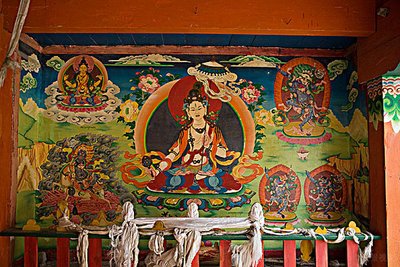
During the reign of the Fifth to the Eighth and later the Thirteenth Dalai Lama, Jokhang Temple was added new buildings, expanded its outer courtyard and increased its fresco area to more than 4,000 square meters.
In addition to a large number of statues of Buddhas, Bodhisattvas, patriarchs, there are also pictures of Princess Wencheng’s Entry into Tibet, celebration, Gushi Khan and Dibasangi Jiacuo, the Fifth Dalai Lama, Xiyang Quji, Xiqin Quji and other historical and cultural customs.
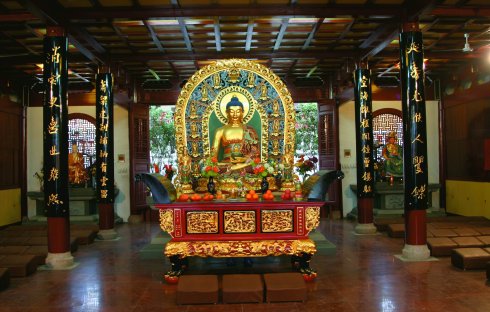
The murals in Jokhang Temple show the achievements of Princess Wencheng's promotion in the Tang Dynasty culture in Tibet, as well as the mural art of the Tang Dynasty, which are not only treasures of history and art, but also tangible memorials of Sino-Tibetan cultural exchanges.
The exquisite and unique mural art of Jokhang Temple is a brilliant pearl in the long history of Chinese mural painting, which has been radiating brilliant colors on the Tibetan Plateau for 1300 years. We can learn about many histories and legends when we see them.
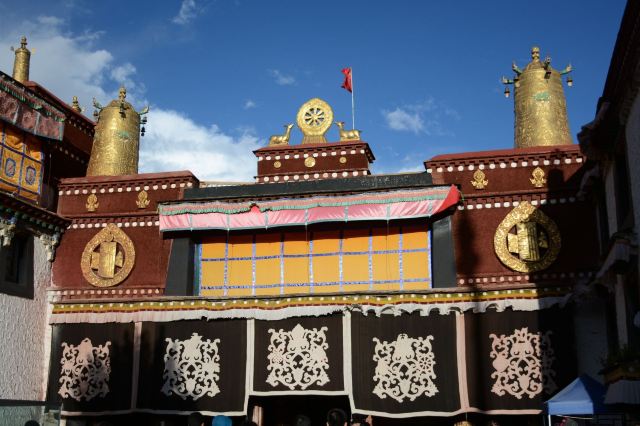
The Maitreya Hall is dominated by a small, delicate Buddha of Maitreya, which used to be carried out and go around the streets of Barkhor every year during the Dharma Assembly. The two statues of Manjusri and Guanyin are set on the left and right sides of Maitreya respectively, and beside them are two different statues of Tara.
In addition, the Maitreya Hall is guarded by four Dharma Protectors with angry faces. On the right side of the gate is the Lord of Dovan (one of the Four Heavenly Kings), and on the left is the god of wealth, Jambala. On the altar is a statue of a Lama with full-lotus posture, who built a dam in Lhasa to protect the city from floods. If you look carefully at the lower-left corner of the Temple when you enter, you will see a small stone goat which is the legendary sacred sheep that fills the lake.
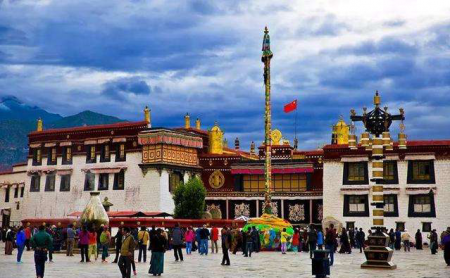
Nangkuo is an inner road inside the Jokhang Temple. People often walk along the Qianfo Corridor around the Chuekang Hall for a sense of satisfaction. This is the "inner circle" of Lhasa's inner, middle and outer routes that used to relay Sutras. There are a large number of visitors to experience for good luck.
The main sutra turning activities in Lhasa are centered on the Sakyamuni Buddha of Jokhang Temple. Besides the "inner circle", around the Jokhang Temple is the "middle circle" or "Bachi", which is the ancient and lively commercial street - Barkhor Street. Around Jokhang Temple, Yaowangshan, Potala Palace and Jokhang Temple is the "outer ring" called "Linkuo", which has encircled most in Lhasa.
The Hall of Eight Medicine Masters
The Main Hall of the Temple of Eight Medicine Masters is revered as the God of Medicine. When people are ill or praying for health, worshippers believe that this temple will help them to ward off illness and strengthen their bodies.
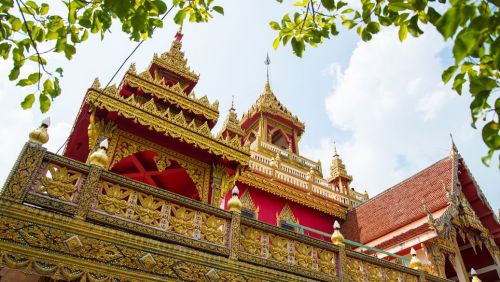
From the ticket office on the ground floor, there is a staircase leading people to the landing on the second and third floors. Overlooking from the platform, the buildings of Potala Palace glow in the dazzling sunlight. From the Golden Roof, you can see the bustling Jokhang Temple Square and also Barkhor Street where is full of Tibetan life. In summer, there is also a tea room where you can relax.
Take bus No. 9, 10, 11 circle line, 12, 15, 18, 19 and get off at the Municipal Maternal and Child Health Hospital Station walk north about 5 minutes.
Take bus No. 23, 25, 28 and get off at Cuomeilin Station and walk north about 5 minutes.
Take bus 7, 8, 20,22, 23, 25, 28 or 29 to Chongsaikang Station and walk south for 5 minutes to get there.
By Taxi
Chinese: 请带我去大昭寺。English: Please take me to the Jokhang Temple.
If you go to the Jokhang Temple from the Lhasa Railway Station, it takes about 35 minutes (about 25 yuan).
If you go to the Jokhang Temple from the Lhasa Gongga International Airport, it takes about 80 minutes (about 250 yuan).
